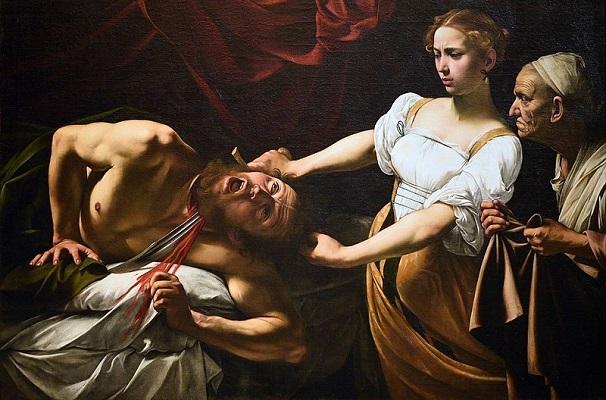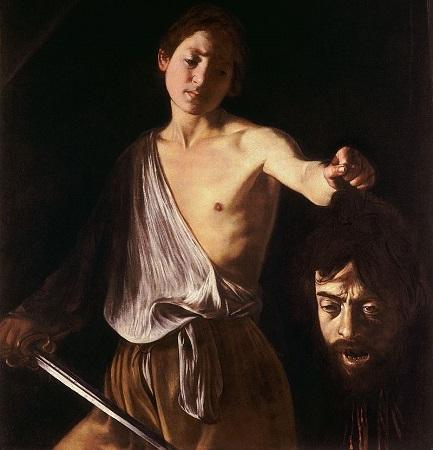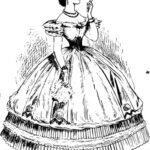
In her poem, “Caravaggio: The Painting of Force and Violence” (2005), Alicia Ostriker offers a vivid ekphrastic account of the paintings of the famed Italian painter, Michelangelo Merisi da Caravaggio. In sections III and IV of the poem, Ostriker describes two different gory paintings of Caravaggio that revolve around decapitation: Judith Beheading Holofernes and David with the Head of Goliath. Yet, despite the thematic similarity, Ostriker seems to treat Judith with a little more regard and deference than David upon close reading.
Ostriker favorably relates to the exact moment that Caravaggio chooses to depict how Judith actually beheads Holofernes in no less than the first eight lines of section III, stating that Caravaggio is like a “chemist” who “explores violence” with “hot fasciation, cold skill” and “unresolved tensions … / Immediately prior to a final result”; only after this enticing opening, Ostriker begins to describe the painting. In comparison, in section IV Ostriker promptly starts to describe Caravaggio’s painting of David after the actual beheading of Goliath – after the “final result” – and when she does briefly regard the painting as a whole, she bleakly acknowledges that “the image conveys no repose, no triumph or calm or ease.” The stark contrast in the general characterization of the two paintings already suggests Ostriker’s higher esteem of Judith than David quite early on in the two sections.

Another indication of Ostriker’s preference is the description of the two central characters in the paintings. Ostriker describes Judith “with a look of disgust and insult / On her housewife’s countenance”: Judith is therefore understandably disgusted, yet the ascribed expression of insult on her mere housewife’s countenance attributes positive conviction to Judith. To add furthermore to Judith’s sympathetic image, Ostriker then approbatively specifies that Judith’s “arms the arms / Of a competent butcher.” David’s physical portrayal, on the other hand, is far less propitious: David’s “compressed lips are hardly at rest,” his “foreshortened arm has already begun to ache,” and “his shoulder will tire soon”; finally, David’s “broken brow” gloomily demonstrates that he “repents [his] past” while he ominously “regards the horror his future holds.” It is also important to note that Ostriker seems to refer to the “creased crone” in Judith Beheading Holofernes in order to reduce some of the foulness from Judith’s gruesome act of beheading as if this crone “maliciously” goads Judith into doing it. The two different verbal representations of the painted characters thus accentuate Ostriker’s advantageous conception of Judith over David.
Ostriker’s depiction of the paintings’ victims also reveals at least somewhat of the preferential treatment of Judith over David. In section III, Holofernes is described uncomplimentary as a “drunken general” who is “twisting… / to try and tell, / Che diavolo“. The general impression from the text is, therefore, that Judith the housewife manages to surprise and overcome Holofernes the general, like another familiar type of David and Goliath parable. Ironically, Ostriker does not really delineate Caravaggio’s David with the Head of Goliath as a David and Goliath parable. There is no mention in section IV of Goliath’s preliminary advantage in size over David and in fact, Goliath’s “opened mouth” and “stunned eyes [that don’t] admit their loss” are recounted only as evidence of the uneasy feeling that the painting elicits, as stated previously. If so, even from the victims’ perspective in the poem, Judith is still represented in a more favorable light than David.
Like the Caravaggio’s paintings it renders, Ostriker’s poem is chilling, grim and even ghastly at times; more importantly, it adds more fictional colors to the scenes and characters in the paintings from Alicia Ostriker’s own mind. It is not fully clear why Ostriker describes Judith more positively than David in her ekphrastic poem – perhaps it is because of gender, perhaps it is because of the stories behind the paintings, or perhaps it is because she simply prefers the aesthetic quality of Judith Beheading Holofernes to David with the Head of Goliath. However, whatever the case may be, Ostriker’s text supplements Caravaggio’s paintings with more piquancy and vivaciousness, at least for those who remain with their heads.
Work Cited
Ostriker, Alicia. “Caravaggio: The Painting of Force and Violence.” No Heaven. U of Pittsburgh P, 2005, pp. 66-69.



